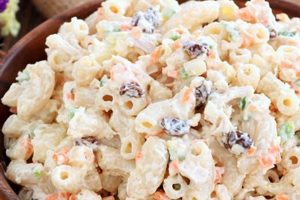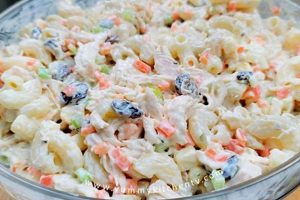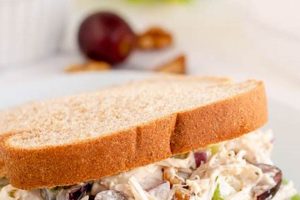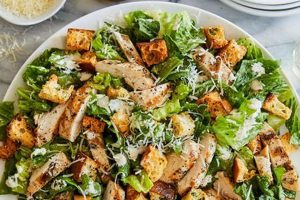A Cobb salad is an American garden salad typically composed of chopped salad greens (such as iceberg lettuce, romaine, watercress, and endive), tomato, crisp bacon, hard-boiled eggs, avocado, chives, blue cheese, and French dressing. A popular variation features grilled chicken breast as a substantial protein source. Recipes often specify precise ingredients and preparation methods, including grilling techniques for the chicken and specific chopping sizes for other components.
This main-dish salad offers a balance of flavors and textures, combining the richness of bacon and blue cheese with the freshness of the vegetables and the lean protein of the chicken. Its customizable nature allows for adjustments to suit individual dietary needs and preferences. The dish originated in the 1930s at the Brown Derby restaurant in Hollywood and has since become a classic in American cuisine, appreciated for its versatility and satisfying combination of ingredients.
Further exploration will cover variations on this popular dish, tips for achieving perfectly grilled chicken, selecting the freshest ingredients, and crafting homemade dressings. Detailed instructions and nutritional information will also be provided to guide the creation of a delightful and wholesome meal.
Tips for a Superior Cobb Salad
Achieving a truly exceptional Cobb salad involves attention to detail in ingredient selection and preparation. These tips offer guidance for creating a balanced and flavorful dish.
Tip 1: Optimal Chicken Preparation: Marinating chicken breast for at least 30 minutes enhances flavor and tenderness. Grilling over medium heat ensures thorough cooking without drying out the meat. Allowing the chicken to rest before slicing preserves its juiciness.
Tip 2: Bacon Perfection: Achieving crispy bacon is crucial for textural contrast. Baking bacon in the oven provides even cooking and minimizes mess. Draining cooked bacon on paper towels removes excess grease.
Tip 3: Egg Excellence: Perfectly cooked hard-boiled eggs enhance both the visual appeal and the flavor of the salad. Adding a teaspoon of baking soda to the boiling water aids in peel removal. Immediately plunging cooked eggs into ice water stops the cooking process and prevents a green ring around the yolk.
Tip 4: Avocado Selection and Handling: Ripe avocados provide a creamy texture and rich flavor. Gently squeezing the avocado indicates ripeness. To prevent browning, slice avocados just before serving and toss with a bit of lemon juice.
Tip 5: Crisp Greens: Thoroughly washing and drying the lettuce ensures a crisp and refreshing salad. Using a salad spinner removes excess water effectively. Tearing the lettuce into bite-sized pieces provides a better eating experience than chopping.
Tip 6: Blue Cheese Selection: High-quality blue cheese adds a pungent and salty element to the salad. Crumbling the cheese rather than slicing allows for even distribution of flavor.
Tip 7: Dressing Considerations: A classic vinaigrette or a creamy blue cheese dressing complements the flavors of the salad. Whisking the dressing just before serving emulsifies the ingredients and enhances its texture.
By following these guidelines, one can elevate a simple Cobb salad into a culinary masterpiece. Careful attention to each component ensures a harmonious blend of flavors and textures.
This comprehensive guide provides a solid foundation for crafting a delicious and visually appealing Cobb salad. The following section offers variations and customizations to further personalize this classic dish.
1. Grilled Chicken
Grilled chicken serves as the central protein component in a grilled chicken Cobb salad, significantly influencing the dish’s overall nutritional value and flavor profile. The grilling process imparts a smoky char and enhances the inherent savory notes of the chicken, contrasting with the fresh, crisp elements of the salad. The choice of marinade and grilling technique directly impacts the final taste and texture of the chicken, affecting the overall balance of the salad. For instance, a citrus-herb marinade complements the vegetables and dressing, while a smoky barbecue marinade introduces a bolder flavor dimension. Over-grilling can result in dry, tough chicken, detracting from the salad’s appeal, while perfectly grilled chicken, juicy and tender, elevates the entire dish.
The inclusion of grilled chicken offers a lean protein source, contributing to the salad’s satiety factor. Compared to other protein options like fried chicken or bacon, grilled chicken provides a healthier alternative without sacrificing flavor. This aspect is crucial for individuals seeking a balanced and nutritious meal. Furthermore, the versatility of grilled chicken allows for seamless integration with various flavor profiles. It serves as a neutral canvas that readily absorbs the flavors of marinades and dressings, allowing for diverse culinary interpretations within the Cobb salad framework. One could create a Southwestern-inspired Cobb salad with grilled chicken marinated in chili-lime, or a Mediterranean version with a lemon-herb marinade.
Understanding the role and impact of grilled chicken in a Cobb salad allows for informed culinary decisions. Selecting appropriate grilling methods, marinades, and ensuring proper cooking time contributes significantly to the overall success of the dish. The interplay between the grilled chicken and other components, such as the dressing and vegetables, determines the final balance of flavors and textures. Mastery of these elements elevates the Cobb salad from a simple combination of ingredients to a carefully orchestrated culinary experience.
2. Crisp Vegetables
Crisp vegetables constitute an essential element of a grilled chicken Cobb salad, providing textural contrast, fresh flavors, and vital nutrients. Their presence balances the richness of the grilled chicken, bacon, and cheese, contributing to a more refreshing and satisfying culinary experience. The selection and preparation of these vegetables significantly influence the salad’s overall quality and appeal.
- Variety and Texture:
A variety of crisp vegetables contributes diverse textures and flavors. Iceberg or romaine lettuce provides a refreshing base, while diced tomatoes offer a juicy burst of sweetness. Other options, such as cucumbers, bell peppers, and red onion, introduce further complexity and textural nuances. The interplay of these crisp elements alongside the other ingredients elevates the salad beyond a simple combination of components.
- Freshness and Quality:
The quality and freshness of the vegetables directly impact the overall flavor and enjoyment of the salad. Selecting fresh, vibrant vegetables ensures optimal crispness and flavor. Proper storage and handling, including thorough washing and drying, maintain the vegetables’ quality and prevent wilting. Pre-cut vegetables should be avoided, as they often lack the desired crispness and freshness.
- Nutritional Contribution:
Crisp vegetables contribute essential vitamins, minerals, and dietary fiber to the salad. This nutritional boost complements the protein from the grilled chicken and creates a more wholesome meal. The diverse range of vegetables offers a wider spectrum of nutrients, enhancing the salad’s health benefits. For instance, dark leafy greens provide Vitamin K, while tomatoes are a source of lycopene.
- Preparation Techniques:
Proper preparation of the vegetables is crucial for maintaining their crispness and preventing a soggy salad. Tearing lettuce leaves instead of chopping them prevents bruising and preserves texture. Dicing vegetables into uniform sizes ensures even distribution throughout the salad and enhances visual appeal. Adding vegetables just before serving maintains their crispness and prevents them from becoming waterlogged.
The careful selection and preparation of crisp vegetables contribute significantly to the overall success of a grilled chicken Cobb salad. Their freshness, variety, and textural contrast elevate the dish from a simple meal to a more complex and satisfying culinary experience. By focusing on these elements, one can achieve a balanced and flavorful salad that highlights the interplay of textures, flavors, and nutritional value.
3. Flavorful Cheese
Flavorful cheese contributes significantly to the complexity and balance of a grilled chicken Cobb salad. The sharp, salty, and often tangy notes of cheese provide a counterpoint to the other ingredients, enhancing the overall sensory experience. Cheese selection impacts not only the flavor profile but also the texture and visual appeal of the salad. The creamy texture of crumbled blue cheese, for example, contrasts with the crisp vegetables and tender chicken, while its distinctive blue veins add visual interest.
The choice of cheese influences the perceived balance of flavors within the salad. Stronger cheeses, like Roquefort or Gorgonzola, assert a more dominant presence, while milder options, such as feta or goat cheese, offer a subtler contribution. Consideration must be given to the other ingredients and the desired overall flavor profile when selecting a cheese. A salad featuring a bold, smoky grilled chicken might benefit from a robust blue cheese, whereas a lighter, herb-marinated chicken might pair well with a milder feta. The quantity of cheese used also affects the balance; too much can overwhelm the other flavors, while too little might render its contribution negligible. Practical applications include using crumbled blue cheese for a classic Cobb, shaved Parmesan for a lighter Italian twist, or a combination of cheeses for a more complex flavor profile.
Careful selection and appropriate use of flavorful cheese elevate the grilled chicken Cobb salad beyond a simple assemblage of ingredients. Understanding the interplay of flavors and textures allows for informed decisions regarding cheese selection, quantity, and integration with the other components. This knowledge enables the creation of a harmonious and well-balanced salad that delivers a satisfying culinary experience. The potential for variations within this framework remains vast, limited only by culinary creativity and the desire for exploration. Further research into specific cheese varieties and their flavor profiles can provide additional insights for crafting personalized and innovative Cobb salad creations.
4. Balanced Dressing
Balanced dressing plays a crucial role in a successful grilled chicken Cobb salad, acting as the unifying element that harmonizes the diverse flavors and textures. The dressing’s role extends beyond simply adding moisture; it contributes significantly to the overall taste, texture, and balance of the salad. A well-balanced dressing complements, rather than overwhelms, the other ingredients, enhancing their individual characteristics while creating a cohesive flavor profile.
- Acidity:
Acidity, often derived from vinegar or citrus juice, provides brightness and cuts through the richness of the other ingredients. A vinaigrette’s tartness balances the fattiness of the chicken, bacon, and cheese, while also enhancing the flavors of the vegetables. Examples include red wine vinegar for a classic flavor, lemon juice for a brighter note, or apple cider vinegar for a touch of sweetness. Proper acidity levels prevent the salad from feeling heavy or overly rich.
- Flavor Intensity:
The dressing’s flavor intensity should complement, not overpower, the other components. A subtly flavored vinaigrette allows the individual flavors of the grilled chicken, vegetables, and cheese to shine through. Conversely, a bolder dressing, such as a creamy blue cheese or ranch, can add a significant layer of flavor but should be used judiciously to avoid masking the other ingredients. The intensity should be carefully calibrated to the overall flavor profile desired.
- Texture and Viscosity:
The dressing’s texture contributes to the overall mouthfeel of the salad. A vinaigrette offers a light and refreshing texture, allowing the crispness of the vegetables to remain prominent. A creamy dressing adds richness and coats the ingredients, providing a different textural experience. The viscosity of the dressing influences how it clings to the other components, affecting both the distribution of flavor and the overall enjoyment of the salad.
- Emulsification and Stability:
A stable emulsion is crucial for a well-balanced dressing, particularly in vinaigrettes. Proper emulsification ensures that the oil and vinegar combine evenly, preventing a separation that can lead to an uneven distribution of flavor. Techniques like whisking or using an emulsifier, such as mustard or egg yolk, create a stable emulsion that enhances the dressing’s texture and ensures a consistent flavor experience throughout the salad.
These facets of balanced dressing are integral to crafting a successful grilled chicken Cobb salad. Careful consideration of acidity, flavor intensity, texture, and emulsification allows for the creation of a dressing that not only complements the other ingredients but elevates the entire dish. The interplay of these elements contributes significantly to the overall balance and enjoyment of the salad, demonstrating the crucial role of a well-crafted dressing in a harmonious culinary composition.
5. Proper Assembly
Proper assembly is crucial for a successful grilled chicken Cobb salad. It directly impacts the final presentation, the even distribution of flavors and textures, and the prevention of sogginess. A well-assembled salad ensures each bite contains a balanced representation of all ingredients, maximizing enjoyment. Conversely, improper assembly can lead to a disorganized, unappetizing appearance and an uneven distribution of components, resulting in some bites lacking key elements or becoming overly saturated with dressing.
Strategic layering of ingredients prevents the salad from becoming soggy. Placing the lettuce at the base creates a barrier against the dressing, preventing it from immediately saturating the more delicate ingredients. Distributing the heavier components, such as the grilled chicken, bacon, and cheese, evenly across the lettuce further helps maintain the salad’s structure. Adding the dressing just before serving prevents the lettuce from wilting and ensures the other ingredients retain their crispness. For instance, placing chopped tomatoes directly on top of the lettuce can cause the lettuce to become watery, whereas arranging them strategically amongst the other ingredients helps maintain overall freshness. Similarly, placing the bacon bits on a paper towel-lined plate before assembly can prevent excess grease from saturating the salad. These seemingly small details can significantly impact the final product.
Proper assembly elevates the grilled chicken Cobb salad from a mere collection of ingredients to a carefully constructed dish. It transforms a simple combination of elements into a visually appealing and texturally satisfying culinary experience. Attention to detail in the assembly process demonstrates care and consideration for the ingredients and ensures the final product is not only delicious but also aesthetically pleasing. This understanding allows for consistent creation of high-quality Cobb salads, demonstrating a mastery of this classic dish.
Frequently Asked Questions
This section addresses common inquiries regarding the preparation and enjoyment of grilled chicken Cobb salad.
Question 1: Can other greens be substituted for iceberg or romaine lettuce?
While iceberg and romaine provide a classic base, other greens like butter lettuce, spinach, or a spring mix offer variations in flavor and texture. Consider the overall flavor profile when substituting.
Question 2: What are suitable alternatives to blue cheese for those with aversions?
Feta, goat cheese, or even a mild cheddar can be substituted for blue cheese. These options provide distinct flavor profiles while maintaining a creamy or crumbly texture.
Question 3: How can the salad be adapted for specific dietary restrictions, such as gluten-free or low-carb?
Omitting croutons addresses gluten-free requirements. For low-carb versions, replace traditional dressings with a vinaigrette and limit or omit high-carbohydrate vegetables like tomatoes. Careful ingredient selection ensures dietary compliance.
Question 4: What is the best method for storing leftover grilled chicken Cobb salad?
Storing ingredients separately maximizes freshness. Combine components just before serving to prevent the salad from becoming soggy. Store the dressing separately to maintain optimal texture and flavor.
Question 5: How can one ensure the grilled chicken remains moist and flavorful?
Marinating the chicken for at least 30 minutes before grilling contributes significantly to both moisture and flavor enhancement. Avoid overcooking, which can lead to dry chicken. Allowing the chicken to rest after grilling helps retain its juices.
Question 6: Can the bacon be prepared using methods other than baking?
Pan-frying or microwaving are viable alternatives to baking bacon. However, baking generally results in more evenly cooked bacon with minimal mess. Regardless of the method, draining excess grease is essential.
These responses address key considerations for creating and enjoying a customized grilled chicken Cobb salad. Understanding these aspects contributes to a successful and satisfying culinary experience.
The subsequent section will explore further variations and customizations, offering additional inspiration for creating personalized Cobb salad masterpieces.
Conclusion
Exploration of this classic American dish reveals the importance of ingredient selection, preparation techniques, and balanced assembly. From the perfectly grilled chicken to the crisp vegetables, flavorful cheese, and balanced dressing, each component contributes significantly to the final product. Proper assembly ensures a harmonious blend of flavors, textures, and visual appeal. Understanding these elements allows for informed culinary choices, enhancing the overall dining experience.
The enduring popularity of the Cobb salad underscores its versatility and adaptability. Continued experimentation with ingredient variations and flavor profiles ensures this classic dish remains a vibrant and evolving culinary creation. Careful attention to detail, from ingredient selection to final assembly, elevates the Cobb salad beyond a simple meal to a testament to culinary craftsmanship and appreciation for fresh, flavorful ingredients.






